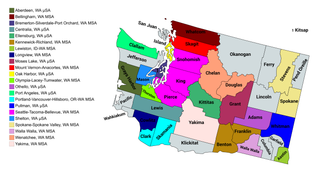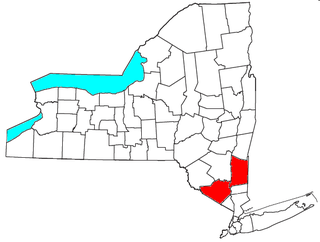Related Research Articles

The Office of Management and Budget (OMB) is the largest office within the Executive Office of the President of the United States (EOP). OMB's most prominent function is to produce the president's budget, but it also examines agency programs, policies, and procedures to see whether they comply with the president's policies and coordinates inter-agency policy initiatives.

The United States Department of Labor (DOL) is one of the executive departments of the U.S. federal government. It is responsible for the administration of federal laws governing occupational safety and health, wage and hour standards, unemployment benefits, reemployment services, and occasionally, economic statistics. It is headed by the secretary of labor, who reports directly to the president of the United States and is a member of the president's Cabinet.
The Standard Industrial Classification (SIC) was a system for classifying industries by a four-digit code as a method of standardizing industry classification for statistical purposes across agencies. Established in the United States in 1937, it is used by government agencies to classify industry areas. Similar SIC systems are also used by agencies in other countries, e.g., by the United Kingdom's Companies House.

The Bureau of Labor Statistics (BLS) is a unit of the United States Department of Labor. It is the principal fact-finding agency for the U.S. government in the broad field of labor economics and statistics and serves as a principal agency of the U.S. Federal Statistical System. The BLS collects, processes, analyzes, and disseminates essential statistical data to the American public, the U.S. Congress, other Federal agencies, State and local governments, business, and labor representatives. The BLS also serves as a statistical resource to the United States Department of Labor, and conducts research measuring the income levels families need to maintain a satisfactory quality of life.
In the United States, a metropolitan statistical area (MSA) is a geographical region with a relatively high population density at its core and close economic ties throughout the region. Such regions are not legally incorporated as a city or town would be and are not legal administrative divisions like counties or separate entities such as states. As a result, sometimes the precise definition of a given metropolitan area will vary between sources. The statistical criteria for a standard metropolitan area were defined in 1949 and redefined as a metropolitan statistical area in 1983.
In the United States census, the U.S. Census Bureau and the Office of Management and Budget define a set of self-identified categories of race and ethnicity chosen by residents, with which they most closely identify. Residents can indicate their origins alongside their race, and are asked specifically whether they are of Hispanic or Latino origin in a separate question.
The Standard Occupational Classification (SOC) System is a United States government system for classifying occupations. It is used by U.S. federal government agencies collecting occupational data, enabling comparison of occupations across data sets. It is designed to cover all occupations in which work is performed for pay or profit, reflecting the current occupational structure in the United States. The 2010 SOC includes 840 occupational types.

The Economic Research Service (ERS) is a component of the United States Department of Agriculture (USDA) and a principal agency of the Federal Statistical System of the United States. It provides information and research on agriculture and economics.
The Information Quality Act (IQA) or Data Quality Act (DQA), passed through the United States Congress in Section 515 of the Consolidated Appropriations Act, 2001. Because the Act was a two-sentence rider in a spending bill, it had no name given in the actual legislation. The Government Accountability Office uses the name "Information Quality Act".

The United States has a racially and ethnically diverse population. At the federal level, race and ethnicity have been categorized separately. The most recent United States census recognized five racial categories, as well as people who belong to two or more of the racial categories. The United States also recognizes the broader notion of ethnicity. The 2000 census and 2010 American Community Survey inquired about the "ancestry" of residents, while the 2020 census allowed people to enter their "origins". The Census Bureau also classified respondents as either Hispanic or Latino, identifying as an ethnicity, which comprises the minority group in the nation.

The Philippine Statistics Authority is the central statistical authority of the Philippine government that collects, compiles, analyzes and publishes statistical information on economic, social, demographic, political affairs and general affairs of the people of the Philippines and enforces the civil registration functions in the country.
The United States federal civil service is the civilian workforce of the United States federal government's departments and agencies. The federal civil service was established in 1871. U.S. state and local government entities often have comparable civil service systems that are modeled on the national system to varying degrees.
Right to know is a human right enshrined in law in several countries. UNESCO defines it as the right for people to "participate in an informed way in decisions that affect them, while also holding governments and others accountable". It pursues universal access to information as essential foundation of inclusive knowledge societies. It is often defined in the context of the right for people to know about their potential exposure to environmental conditions or substances that may cause illness or injury, but it can also refer more generally to freedom of information or informed consent.
Executive Schedule is the system of salaries given to the highest-ranked appointed officials in the executive branch of the U.S. government. The president of the United States appoints individuals to these positions, most with the advice and consent of the United States Senate. They include members of the president's Cabinet, several top-ranking officials of each executive department, the directors of some of the more prominent departmental and independent agencies, and several members of the Executive Office of the President.

The U.S. state of Washington has 28 statistical areas that have been delineated by the Office of Management and Budget (OMB). On March 6, 2020, the OMB delineated six combined statistical areas, 13 metropolitan statistical areas, and nine micropolitan statistical areas in Washington. The largest of them is the Seattle metropolitan area, which had a population of 4,018,762 as of the 2020 census.

The Federal Geographic Data Committee (FGDC) is a United States government committee which promotes the coordinated development, use, sharing, and dissemination of geospatial data on a national basis. Its 32 members are representatives from the Executive Office of the President, and Cabinet level and independent federal agencies. The secretary of the Department of the Interior chairs the FGDC, with the deputy director for management, Office of Management and Budget (OMB) as vice-chair.

The Kiryas Joel-Poughkeepsie-Newburgh, NY Metropolitan Statistical Area, as defined by the United States Office of Management and Budget, is an area consisting of two counties in New York's Hudson Valley, with the municipalities of Kiryas Joel, Poughkeepsie, and Newburgh as its principal cities. As of the 2020 census, the MSA had a population of 679,221. The area was centered on the urban area of Poughkeepsie-Newburgh. Prior to July 2023, it was known as the Poughkeepsie-Newburgh-Middletown, NY Metropolitan Statistical Area; whereupon it was renamed to its current name, to reflect population changes among its largest municipalities.
The Federal Statistical System of the United States is the decentralized network of federal agencies which produce data and official statistics about the people, economy, natural resources, and infrastructure of the United States. It is led by the Chief Statistician of the United States (CSOTUS) and the Interagency Council on Statistical Policy, and is composed of 13 principal statistical agencies and 3 recognized statistical units, 24 Statistical Officials, approximately 100 additional Federal statistical programs engaged in statistical activities, and several cross system interagency and advisory bodies.

The 2030 United States census, known as "Census 2030", will be the twenty-fifth United States national census. National Census Day, the reference day used for the census, will be April 1, 2030.

Karin A. Orvis is a U.S. government official who has been appointed to become the Chief Statistician of the United States in May, 2022. She will be in charge of the Statistical Policy Branch of the Office of Information and Regulatory Affairs.
References
- 1 2 "Directive No. 1: Fundamental Responsibilities of Federal Statistical Agencies and Recognized Statistical Units" (PDF). U.S. Government Publishing Office . 2014. Retrieved March 28, 2024.
 This article incorporates text from this source, which is in the public domain .
This article incorporates text from this source, which is in the public domain . - 1 2 "Statistical Programs & Standards | OMB". The White House. Retrieved 2024-03-28.
 This article incorporates text from this source, which is in the public domain .
This article incorporates text from this source, which is in the public domain . - ↑ "Directive 2: Office of Management and Budget Standards and Guidelines for Statistical Surveys" (PDF). The White House. September 2006. Retrieved March 28, 2024.
- ↑ "Directive No. 4: Release and Dissemination of Statistical Products Produced by Federal Statistical Agencies" (PDF). U.S. Government Publishing Office . 2008.
- ↑ "Directive No. 10: Standard Occupational Classification (SOC)" (PDF). U.S. Government Publishing Office . 2017. Retrieved March 28, 2024.
- ↑ Orvis, Karin (2024-03-28). "OMB Publishes Revisions to Statistical Policy Directive No. 15: Standards for Maintaining, Collecting, and Presenting Federal Data on Race and Ethnicity | OMB". The White House. Retrieved 2024-03-28.
- ↑ "U.S. Office of Management and Budget's Statistical Policy Directive No. 15: Standards for Maintaining, Collecting, and Presenting Federal Data on Race and Ethnicity". U.S. Office of Management and Budget Interagency Technical Working Group on Race and Ethnicity Standards. Retrieved March 28, 2024.
- ↑ "Statistical Policy Directives of the Office of Management and Budget : U.S. Bureau of Labor Statistics". Bureau of Labor Statistics . Retrieved 2024-03-28.
- ↑ "USDA ERS - OMB Statistical Policy Directives". USDA Economic Research Service . Retrieved 2024-03-28.